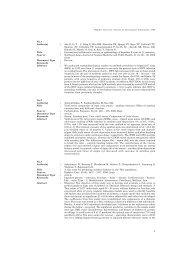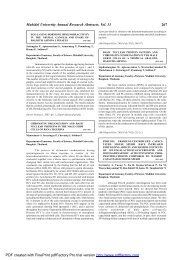Faculty of Pharmacy - Mahidol University
Faculty of Pharmacy - Mahidol University
Faculty of Pharmacy - Mahidol University
You also want an ePaper? Increase the reach of your titles
YUMPU automatically turns print PDFs into web optimized ePapers that Google loves.
300 <strong>Faculty</strong> <strong>of</strong> <strong>Pharmacy</strong><br />
vaccine against SARS is available. However, it was found that a<br />
mixture <strong>of</strong> two HIV-1 proteinase inhibitors, lopinavir and ritonavir,<br />
exhibited some signs <strong>of</strong> effectiveness against the SARS virus. To<br />
understand the fine details <strong>of</strong> the molecular interactions between these<br />
proteinase inhibitors and the SARS virus via complexation, molecular<br />
dynamics simulations were carried out for the SARS-CoV 3CL(pro)<br />
free enzyme (free SARS) and its complexes with lopinavir (SARS-<br />
LPV) and ritonavir (SARS-RTV). The results show that flap closing<br />
was clearly observed when the inhibitors bind to the active site <strong>of</strong><br />
SARS-CoV 3CL(pro). The binding affinities <strong>of</strong> LPV and RTV to<br />
SARS-CoV 3CL(pro) do not show any significant difference. In<br />
addition, six hydrogen bonds were detected in the SARS-LPV system,<br />
while seven hydrogen bonds were found in SARS-RTV complex.<br />
(Journal <strong>of</strong> Theoretical Biology Volume 254, Issue 4, 21 October<br />
2008, Pages 861-867) (This work was jointly supported by the<br />
Commission on Higher Education and the Thailand Research Fund<br />
(MRG4880041)<br />
FORENSIC DETECTION OF MARIJUANA TRACE<br />
(NO. 816)<br />
Thitika Kitpipit 1 , Nathinee Panvisavas 1,2 , Nuntavan<br />
Bunyapraphatsara 3<br />
1Forensic Science Graduate Programme, <strong>Faculty</strong> <strong>of</strong> Scinece,<br />
<strong>Mahidol</strong> Univerfsity, Bangkok 10400, Thailand; 2Department <strong>of</strong><br />
Plant Science, <strong>Faculty</strong> <strong>of</strong> Science, <strong>Mahidol</strong> <strong>University</strong>, Thailand;<br />
3Deparment <strong>of</strong> Pharmacognosy, <strong>Faculty</strong> <strong>of</strong> <strong>Pharmacy</strong>, <strong>Mahidol</strong><br />
<strong>University</strong>, Thailand.<br />
Key words : DNA, Forensic, Marijuana, TLC, Trace<br />
In this study, we compared the use <strong>of</strong> both chemical and<br />
biological tests for precise screening. Marijuana leaves had been<br />
treated in simulated conditions according to the way they are<br />
consumed; leaves materials were boiled in water for 5 min to 8 h.<br />
dried in hot-air oven, air-dried in shade and sunlight, and burned to<br />
black and white ashes. The THC band was detected in the TLC<br />
fingerprints <strong>of</strong> all samples, except the white ash extract. In contrast,<br />
the 197-bp mitochondrial trnL-F fragment was amplified in two<br />
samples, i.e., the DNA extracted from fresh marijuana leaves that<br />
were boiled for 5 min and some <strong>of</strong> the dried marijuana sample. The<br />
results suggested that TLC was a robust method for the detection <strong>of</strong><br />
THC in marijuana. However, DNA analysis seems to be limited when<br />
DNA from heat-treated materials were analyzed 2008 Elsevier<br />
Ireland Ltd. All rights reserved.<br />
(Forensic Science International : Genetics Supplement Series; 1(1)<br />
August 2008: 600-602.)<br />
THE SMOOTHNESS OF BLOOD PRESSURE<br />
CONTROL OF RAMIPRIL IN ESSENTIAL<br />
HYPERTENSIVE THAI PATIENTS EVALUATION<br />
BY 24-HOUR AMBULATORY BLOOD PRESSURE<br />
MONITORING. (NO. 817)<br />
Uchaipichat, V. 1,4 , Koanantakul, B 2 , Suthisisang, C 3<br />
1 Department <strong>of</strong> <strong>Pharmacy</strong> Practice, <strong>Faculty</strong> <strong>of</strong> Pharmaceutical<br />
Sciences, Khon Kaen <strong>University</strong>, Khon Kaen, Thailand; 2 Division<br />
<strong>of</strong> Medicine, Bhumibol Adulyadej Hospital, Bangkok, Thailand;<br />
3 Department <strong>of</strong> Pharmacology, <strong>Faculty</strong> <strong>of</strong> <strong>Pharmacy</strong>, <strong>Mahidol</strong><br />
<strong>University</strong>, Bangkok, Thailand; 4 Department <strong>of</strong> <strong>Pharmacy</strong><br />
Practice, <strong>Faculty</strong> <strong>of</strong> Pharmaceutical Sciences, Khon Kaen<br />
<strong>University</strong>, Khon Kaen 40002, Thailand.<br />
Key words : Angiotensin converting enzyme inhibitor; Blood<br />
pressure variability; Hypertension<br />
Objective: Evaluate the efficacy <strong>of</strong> ramipril 2.5 and 5 mg<br />
once daily on the degree and homogeneity <strong>of</strong> 24-hour blood pressure<br />
reduction in essential hypertensive Thai patients. Material and<br />
Method: Nineteen male subjects, aged 30 to 60 years, with newly<br />
diagnosed essential hypertension were evaluated using the 24-hour<br />
ambulatory blood pressure (24-h ABP) measurement. Results: Twelve<br />
subjects responded and/or normalized with ramipril once daily, where<br />
the <strong>of</strong>fice and 24-h ABP were decreased significantly from baseline<br />
(p < 0.01). The percentage and magnitude <strong>of</strong> 24-h SBP/DBP loads<br />
after treatment were significantly decreased from 92 9.7/91 15.9<br />
to 67 23.8/65 27.6 (p < 0.01) and from 23 10.6/16 5.3 mmHg<br />
to 17 10.3/10 4.8 mmHg (p < 0.05). Trough to peak ratio for<br />
SBP/DBP was 0.59/0.52 (overall estimated) and 0.68 0.23/0.52<br />
0.22 (individual estimated), while the smoothness index was 0.89/<br />
1.03. Conclusion: Ramipril 2.5 and 5 mg once daily exerted the<br />
smooth 24-hour blood pressure reduction in essential hypertensive<br />
Thai patients.<br />
(Journal <strong>of</strong> the Medical Association <strong>of</strong> Thailand Volume 91, Issue 9,<br />
September 2008, Pages 1468-1477.)<br />
EFFECT OF FENOFIBRATE THERAPY ON<br />
PARAOXONASE1 STATUS IN PATIENTS WITH<br />
LOW HDL-C LEVELS (NO. 818)<br />
Wimon Phuntuwate 1 , Chuthamanee Suthisisang 1 , Banhan<br />
Koanantakul .2 , Preecha Chaloeiphap 3 , Bharit Mackness 4 , Mike<br />
Mackness. 4<br />
1 Department <strong>of</strong> Pharmacology, <strong>Faculty</strong> <strong>of</strong> <strong>Pharmacy</strong>, <strong>Mahidol</strong><br />
<strong>University</strong>, Sri Ayudhaya Road, Bangkok, 10400, Thailand;<br />
2 Cardiac and Preventive Center, Bhumibol Adulyadej Hospital,<br />
Bangkok, 10200, Thailand; 3 Division <strong>of</strong> Preventive Medicine,<br />
Royal Thai Air Force, Bangkok, 10200, Thailand; 4 <strong>University</strong> <strong>of</strong><br />
Manchester, Department <strong>of</strong> Medicine, Manchester Royal<br />
Infirmary, Oxford Road, Manchester, M13 9WL, United<br />
Kingdom<br />
Key words : Fen<strong>of</strong>ibrate; HDL-C; Oxidized LDL; Paraoxonase1<br />
Objectives: We evaluated the effect <strong>of</strong> micro-coated<br />
fen<strong>of</strong>ibrate on lipid parameters, high sensitivity C-reactive protein<br />
and paraoxonase1 levels in dyslipidemic patients with low highdensity<br />
lipoproteins levels. In addition, the effects <strong>of</strong> the paraoxonase1<br />
polymorphisms on lipid and paraoxonase1 responses to fen<strong>of</strong>ibrate<br />
therapy were examined. Methods: A total <strong>of</strong> 61 dyslipidemic patients<br />
with low high-density lipoproteins levels were recruited into this study<br />
to receive micro-coated fen<strong>of</strong>ibrate (160 mg/day) for 12 weeks. Lipid<br />
parameters, C-reactive protein, paraoxonase1 concentration and<br />
activity were measured at baseline and after 6 and 12 weeks <strong>of</strong><br />
fen<strong>of</strong>ibrate treatment. Four polymorphisms in both the coding (L55M<br />
and Q192R) and regulatory regions (T-108C and G-909C) <strong>of</strong> human<br />
paraoxonase1 were also quantified. Results: Micro-coated fen<strong>of</strong>ibrate

















